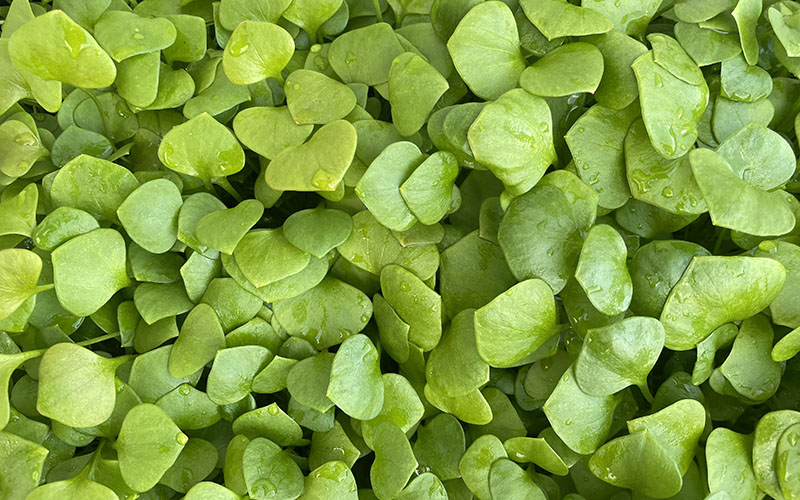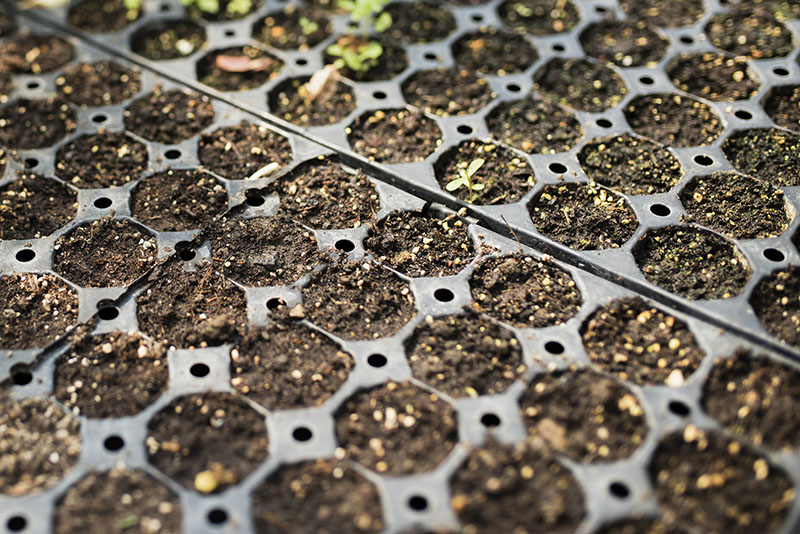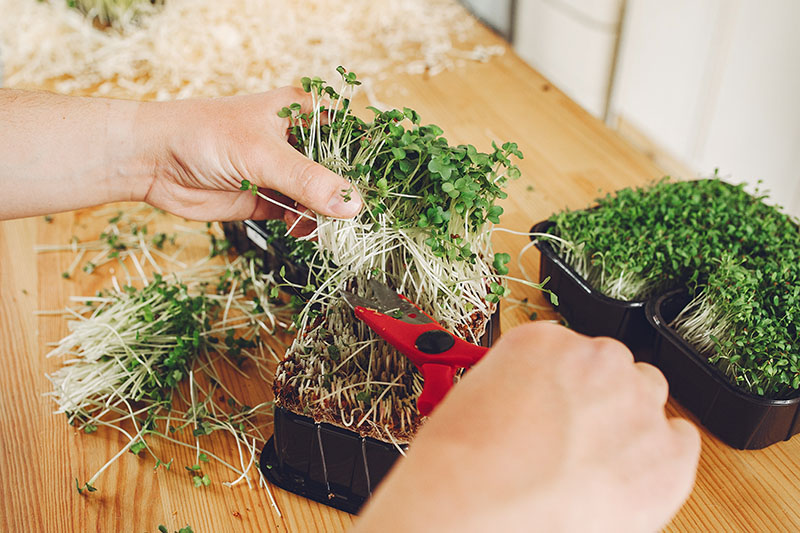
Exploring Ingredients: Winter Purslane

Winter purslane (latin name, Claytonia perfoliata), also known as Miner’s lettuce, is a relatively new addition to our kitchen garden and has provided us with some delicious fresh salad greens throughout the coldest months.
From a few seeds scattered into a trough towards the end of autumn, it has flourished becoming a mini forest to snip as and when needed. The trough has a plastic lid that protected the young plants during the heavy snowfall and hard frosts, but otherwise, winter purslane is a tough little grower.
Origins and a little history
Winter purslane is native to western mountain and coastal regions of North America and as its name suggests it has the ability to grow during the winter months in mild climates, making it a valuable source of fresh greens when other vegetables are scarce.
In the time of the California Gold Rush, miners were known to consume a plant called Miner’s lettuce to prevent scurvy. This nickname refers to the plant’s popularity among miners who were looking for a way to avoid the debilitating disease. Native American peoples likely passed on this knowledge to the miners, as they were already aware of the plant’s health benefits. Scurvy is caused by a deficiency in vitamin C, which is found in high amounts in Miner’s lettuce, as well as other leafy greens. Additionally, the plant contains essential minerals like iron and calcium, making it a nutritious and healthy food choice.
What does winter purslane taste like?
Winter purslane leaves have a slightly succulent nature and a unique combination of tang and sweetness with a subtle earthy flavour. The texture is comparable to spinach or watercress, with the fine stems being crunchy and just as edible as the tender leaves.
Winter purslane has some similarities to spinach, which can sometimes have a slightly bitter taste. However, winter purslane is typically much milder and has a fresher flavour. This makes it an excellent choice for those who do not particularly enjoy the strong flavour of leafy greens like kale or spring greens.
The flowers make a lovely and appealing addition to salads. However, once the plant has finished flowering and produced seeds, it becomes rather bitter and loses its palatability, much like lettuce.
How to use winter purslane in cooking

 Add it to salads
Add it to salads
Winter purslane has a mild and refreshing taste that pairs well with other greens in salads. You can use it as a substitute for lettuce, or mix it with other leafy greens like spinach, watercress or rocket. Dress your salad with your favourite vinaigrette, or keep it simple with just a squeeze of lemon and a drizzle of olive oil.
 Make a pesto
Make a pesto
You can also make a winter purslane pesto by blending it with garlic, olive oil, parmesan cheese, and pine nuts. This can be used as a topping for pasta, sandwiches, or as a dip for vegetables.
Because winter purslane is relatively delicate it is best appreciated fresh and raw but you can still cook it into the following:
 Make a soup
Make a soup
Winter purslane can also be used in soups, adding a bright, fresh flavour to hearty stews and broths. Try adding it to a chicken or vegetable soup, or use it in a traditional minestrone.
 Stir-fry it
Stir-fry it
Try stir-frying winter purslane with garlic and other vegetables, such as onions, peppers, and mushrooms. This makes a delicious and healthy side dish to accompany your main meal.
 Use it in place of spinach
Use it in place of spinach
Since winter purslane has a similar texture to spinach, you can use it as a substitute in recipes that call for spinach. Try using it in quiches, lasagne, or as a topping for pizza.
Where can I buy winter purslane?
Winter purslane is not as commonly available as some other leafy greens, but you may be able to find it at specialty grocery shops, farmers markets or online from a speciality produce supplier. Rather than hunting high and low for it though, we can recommend growing your own from seed. It really is so easy to cultivate and can be grown in a patch in the garden or even in a container as you don’t need lots of space.
Seed is generally inexpensive and easy to come by (we have listed some reliable UK suppliers at the end of this article).
How to grow winter purslane
If you’d like to try growing your own winter purslane here are some tips for starting from seed:

Planting
Winter purslane is a cool-season crop, and it’s best to plant the seeds in the late summer or early autumn, about half centimetre (quarter inch) deep in well-draining soil.
Watering
Water your winter purslane regularly, but be careful not to overwater, as this can lead to root rot. The soil should be kept moist but not waterlogged.
Sunlight
Winter purslane prefers full sunlight or partial shade, and it will do best in a location that receives at least six hours of sun per day.
Fertilising
You can fertilise your winter purslane with a general purpose plant food once a month, but it’s not strictly necessary.
Harvesting
You can begin harvesting winter purslane leaves when they are about 5-8cm (2-3 inches) in size. Be sure to harvest the leaves regularly to encourage new growth, being careful to only remove a few leaves from each plant so they can generate new growth.
Overall, winter purslane is a relatively low-maintenance plant that can be grown in most moderate climates. It’s a great choice for gardeners who are looking for a unique and nutritious addition to their vegetable garden.
Can winter purslane be grown as a cress or microgreen?

To grow winter purslane as a microgreen or cress, you can follow the same basic steps as you would to grow it as a larger plant. Simply sow the seeds in a shallow tray or container filled with potting compost, and keep the soil moist but not waterlogged. Place the container in a sunny location, and the winter purslane should start to sprout within a few days.
Winter purslane is also relatively easy to grow, and it doesn’t require a lot of maintenance or special care. With a little bit of attention and regular harvesting, you can enjoy a bountiful crop of fresh, healthy greens all winter long.
Seed suppliers for winter purslane*
Chiltern Seeds – chilternseeds.co.uk
D.T. Brown – dtbrownseeds.co.uk
Jekka’s – jekkas.com
Johnsons – johnsons-seeds.com
Mr Fothergill’s – mr-fothergills.co.uk
Premier Seeds Direct – www.premierseedsdirect.com
* The Artisan Food Trail is not affiliated with any of these companies.
Photo (main image): © childsdesign
Sign up to receive our newsletter
For the latest producer info, shows, markets, recipes, competitions and more each month.
Please be assured that we don't sell or pass on your information to third parties.
Keep up to date with:
- New and approved producers and produce
- Offers, discounts, competitions and more
- Seasonal produce and great tasting downloadable recipe ideas
- Shows, events and markets

 Add it to salads
Add it to salads Make a pesto
Make a pesto Make a soup
Make a soup Stir-fry it
Stir-fry it Use it in place of spinach
Use it in place of spinach